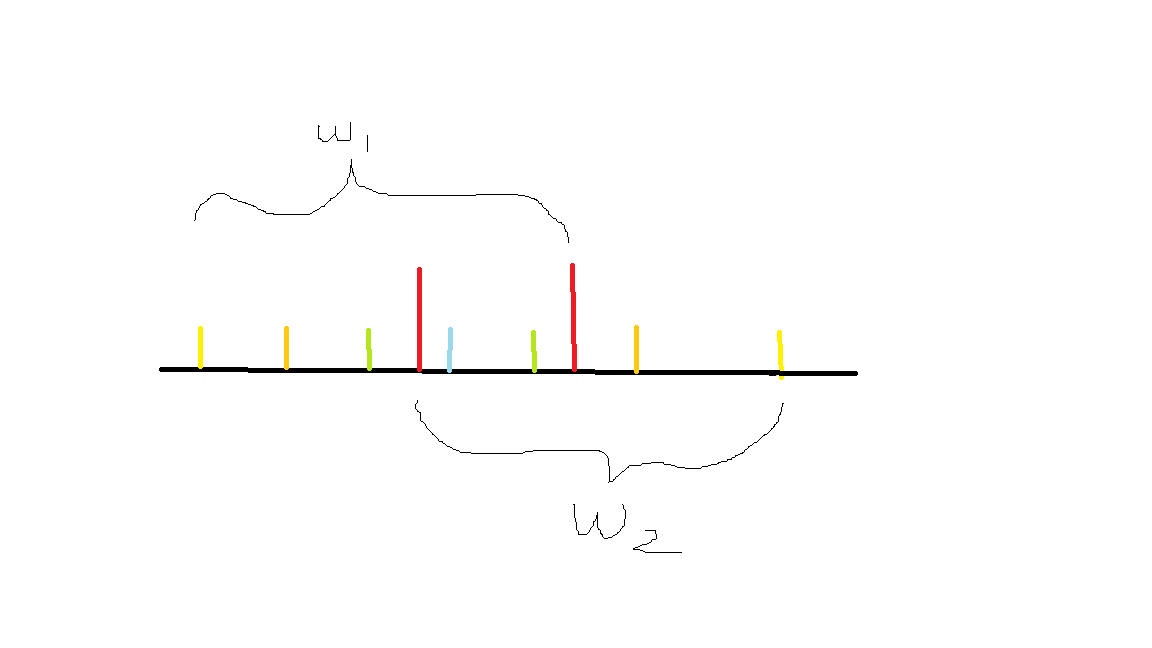前言
感觉这道题的结论好神。。。这里介绍两种做法 QwQ。
法一
法一就是用左偏树,好了咱们继续。
Solution
首先有一个奇妙的处理:由于我们的 b 序列是严格递增的,为了方便之后的计算,在输入的时候先将 \(\mathtt{a[i]}\) 减去 i。
为什么呢?我们发现,a 数组的每个元素都比自己前面一位的元素多减去 1。所以现在每个 \(\mathtt{a[i]}\) 对应的 \(\mathtt{b[i]}\) 其实都是减了 i 的。想一想,如果在没减 i 之前,有 \(\mathtt{b[i]==b[i+1]}\),那么减去 i 之后就有 \(\mathtt{b[i]==b[i+1]+1}\),由于我们保证有 \(\mathtt{b[i]<b[i+1]}\),这种情况也就自然地规避了。
然后这里放上黄源河的论文《左偏树的特点及其应用》节选。


如果看懂了可以直接往下跳,如果没看懂,就来看看我的口胡吧。毫无防备地流下了属于真正弱者的眼泪。
先放图。(注意这是证明情况二)

假设我们将 a 数组分成了这样几个点(相同颜色代表是一组)。如果我们选取中位数的话,那所需的花费不就是所有的两个一样的颜色之间的距离吗?
我们考虑 b 数组递增的情况(b 数组相同的话就是初一的知识了 QwQ)。

如果在整个大区间里,显然这是没有中位数优的。(当然可以有相等的情况,如果对对相等且位置对头,花费和中位数实际上是一样的)
在外面晃荡就更不可能了。
如果是两者合并的话也可以用同样的方式证明。
Code
因为套了模板,代码有点长。。。
#include <cmath>
#include <cstdio>
#include <iostream>
using namespace std;
typedef long long ll;
const int N = 1e6 + 5;
int n, head[N], dot[N << 1], nxt[N << 1], cnt, a[N];
struct LT {
int f[N], son[N][2], dis[N], siz[N], l[N], r[N], tp;
ll val[N];
void init(const int n) {
for(int i = 1; i <= n; ++ i) {
son[i][0] = son[i][1] = dis[i] = 0;
f[i] = i; siz[i] = 1; l[i] = r[i] = i;
}
}
int Find(const int x) {return x == f[x] ? x : f[x] = Find(f[x]);}
bool cmp(const int x, const int y) {return Find(x) == Find(y);}
int unite(int x, int y) {
if(! x || ! y) return x + y;
if(a[x] < a[y]) swap(x, y);
son[x][1] = unite(son[x][1], y); f[son[x][1]] = x;
if(dis[son[x][0]] < dis[son[x][1]]) swap(son[x][0], son[x][1]);
}
int del(const int x) {
int l = son[x][0], r = son[x][1];
son[x][0] = son[x][1] = dis[x] = 0;
f[l] = l; f[r] = r;
return unite(l, r);
}
void solve() {
ll ans = 0;
for(int i = 1; i <= n; ++ i) {
++ tp;
f[tp] = l[tp] = r[tp] = i; siz[tp] = 1; val[tp] = a[i];
while(tp != 1 && val[tp - 1] > val[tp]) {
-- tp; f[tp] = unite(f[tp], f[tp + 1]);
siz[tp] += siz[tp + 1]; r[tp] = r[tp + 1];
while(siz[tp] > (r[tp] - l[tp] + 2) / 2)//因为只有后面的中位数小于前面的才合并,所以大于中位数的值没有用了!!!
-- siz[tp], f[tp] = del(f[tp]);
val[tp] = a[f[tp]];
}
}
tp = 1;
for(int i = 1; i <= n; ++ i) {
if(r[tp] < i) ++ tp;
ans += abs((double) val[tp] - a[i]);
}
printf("%lld\n", ans);
tp = 1;
for(int i = 1; i <= n; ++ i) {
if(r[tp] < i) ++ tp;
printf("%lld ", val[tp] + i);
}
}
}T;
ll read() {
ll x = 0, f = 1; char s;
while((s = getchar()) < '0' || s > '9') if(s == '-') f = -1;
while(s >= '0' && s <= '9') {x = (x << 1) + (x << 3) + (s ^ 48); s = getchar();}
return x * f;
}
int main() {
n = read();
for(int i = 1; i <= n; ++ i) a[i] = read() - i;
T.solve();
return 0;
}
法二
看到大佬用的 STL,写一写。留坑待填。
\(\text{Update on 2022.8.16}\):就是 \(\text{Slope Trick}\) 啦,暂时设置了密码,想看可以私信找我要~

 浙公网安备 33010602011771号
浙公网安备 33010602011771号